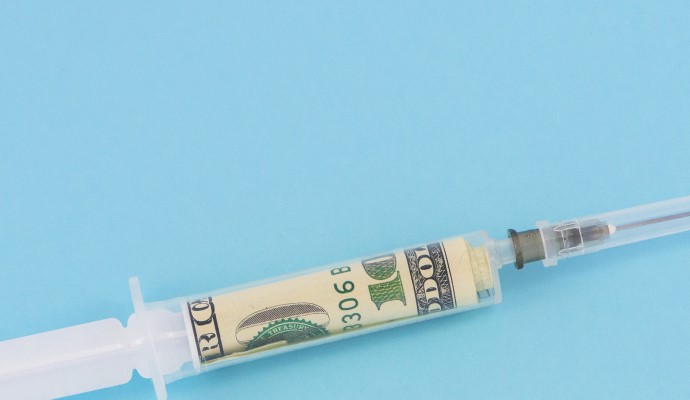Before COVID-19, Healthcare Spending Increased by 4.6%
An acceleration in personal healthcare spending, especially on hospital care and prescription drugs, contributed to the growth, AMA reports.

Source: Getty Images
- National healthcare spending continued to grow right before the COVID-19 pandemic hit, increasing by 4.6 percent in 2019 to a total of $3.8 trillion, the American Medical Association (AMA) reports.
Broken down, that equates to $11,582 per capita and accounts for 17.7 percent of gross domestic product (GDP), the industry group stated in its latest Policy Research Perspective report analyzing US National Health Expenditures (NHE) data from CMS.
Healthcare spending growth in 2019 was in line with the previous years during which expenditures on healthcare increased by 4.7 percent in 2018 and 4.6 percent in 2016. Healthcare spending also accounted for 17.6 percent of GDP in 2018.
AMA described 2019 healthcare spending growth as stable and attributed that to accelerating personal healthcare costs on hospital care and prescription drugs that year.
Personal healthcare expenditures made up the majority (84.5 percent) of total healthcare spending that year, with hospital care costs dominating this category. Spending on hospital care represented 31.4 percent of $1,192.0 billion in personal health expenditures, while prescription drugs came in second at 9.7 percent or $369.7 billion.
In comparison, personal healthcare expenditures on physician services accounted for 14.9 percent or $565.5 billion and clinical services 5.4 percent or $206.6 billion. The difference between the two categories being that physician services consisted of spending in establishments where physician services are the primary activity and clinical services included spending made in outpatient care centers.
To a smaller degree, personal healthcare expenditures also included spending on nursing care facilities (4.6 percent of total health spending or $172.7 billion), home health (3.0 percent or $113.5 billion), and other personal healthcare services (15.5 percent or $587.1 billion).
Spending on personal healthcare services was up by 5.2 percent in 2019, with hospital care increasing by 6.2 percent, clinical services by 5.8 percent, and prescription drugs by 5.7 percent.
Personal healthcare expenditures have been rising over the last ten years, AMA stated in the report. The average annual growth rate for the decade-long period ending in 2019 was 4.3 percent. However, the growth rate includes several variations during the period, including a spike during implementation of the Affordable Care Act (5.2 percent in 2014 and 6.0 percent in 2015) and drops to 4.1 percent in 2017 and 2018.
Notably, AMA found that clinical services (8.3 percent) and hospital care (4.5 percent) had the highest ten-year average rate while prescription drugs (3.8 percent) and physician services (3.4 percent) had the lowest.
In 2019, the growth in personal healthcare expenditures was largely driven by an increase in non-price factors, such as use and intensity of services. Meanwhile, growth in prices declined for hospital care and prescription drugs and remained stable for physician services.
Payers foot the majority of this bill in 2019, spending $2,752.8 billion or 72.5 percent that year. Other third-party payers and programs and public health activities paid for 11.4 percent of $434.4 billion and out-of-pocket spending was attributed to 10.7 percent or $406.5 billion.
Of the payers, private health insurers spent the most (31.5 percent of health spending or $1,195.1 billion), followed by Medicare (21.1 percent or $799.4 billion) and Medicaid (16.2 percent or $613.5 billion).
But while private payers have spent the most over the last couple of years compared to other payers, Medicare spending growth reached a new high of 6.7 percent. The report attributed the growth to the acceleration in personal healthcare expenditures in Medicare private plans.
Out-of-pocket spending growth also reached its highest rate in a decade, coming in at 4.6 percent in 2019.
But the COVID-19 pandemic could disrupt trends in healthcare spending, AMA stated.
NHE data for 2020 won’t be released until the end of the year. However, preliminary reports form the non-profit research organization Altarum estimate national healthcare spending in 2020 to be 2.0 percent lower compared to figures from 2019, marking the first decrease in annual spending as far back as 1960.
Researchers predict significant declines in most personal healthcare expenditure categories, but especially hospital care. As expected, these declines are tied to low volumes from the spring of 2021 when the first outbreaks of COVID-19 hit, which never fully recovered by the end of the year.
This downward trend could help Medicare, which new data shows was not hit as badly in 2020 as expected. Total Medicare fee-for-service costs for COVID-19 were $6.3 billion, and the mean hospitalization cost was $21,752, according to a recent study.
“The researchers' analysis indicated, perhaps surprisingly, that COVID-19 did not have a major financial impact on Medicare in 2020,” explained an accompanying article published in Annals of Internal Medicine. “They found that the average cost of treatment was considerable among those who were hospitalized, but the costs for milder cases—which represented the majority—were relatively small.”
